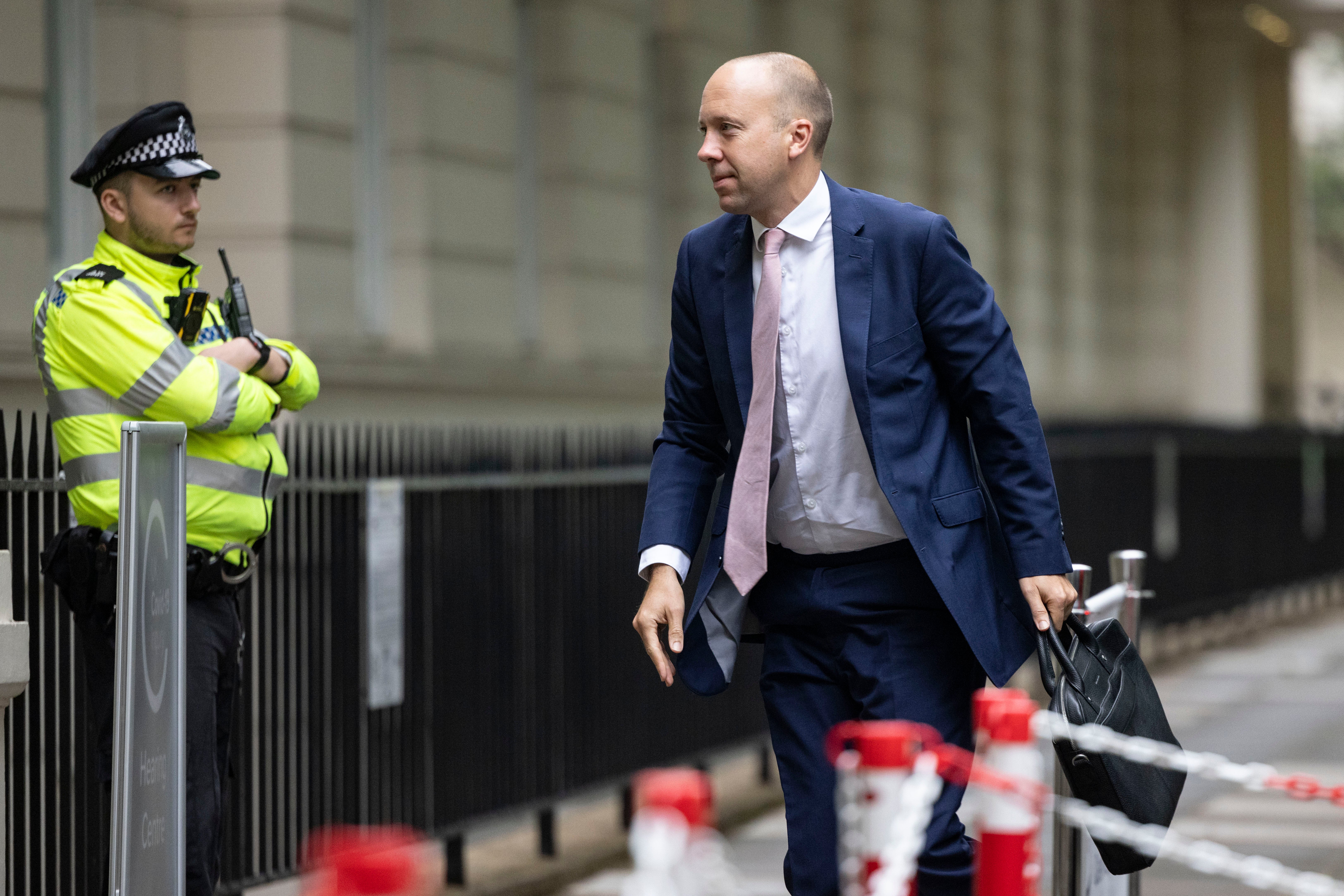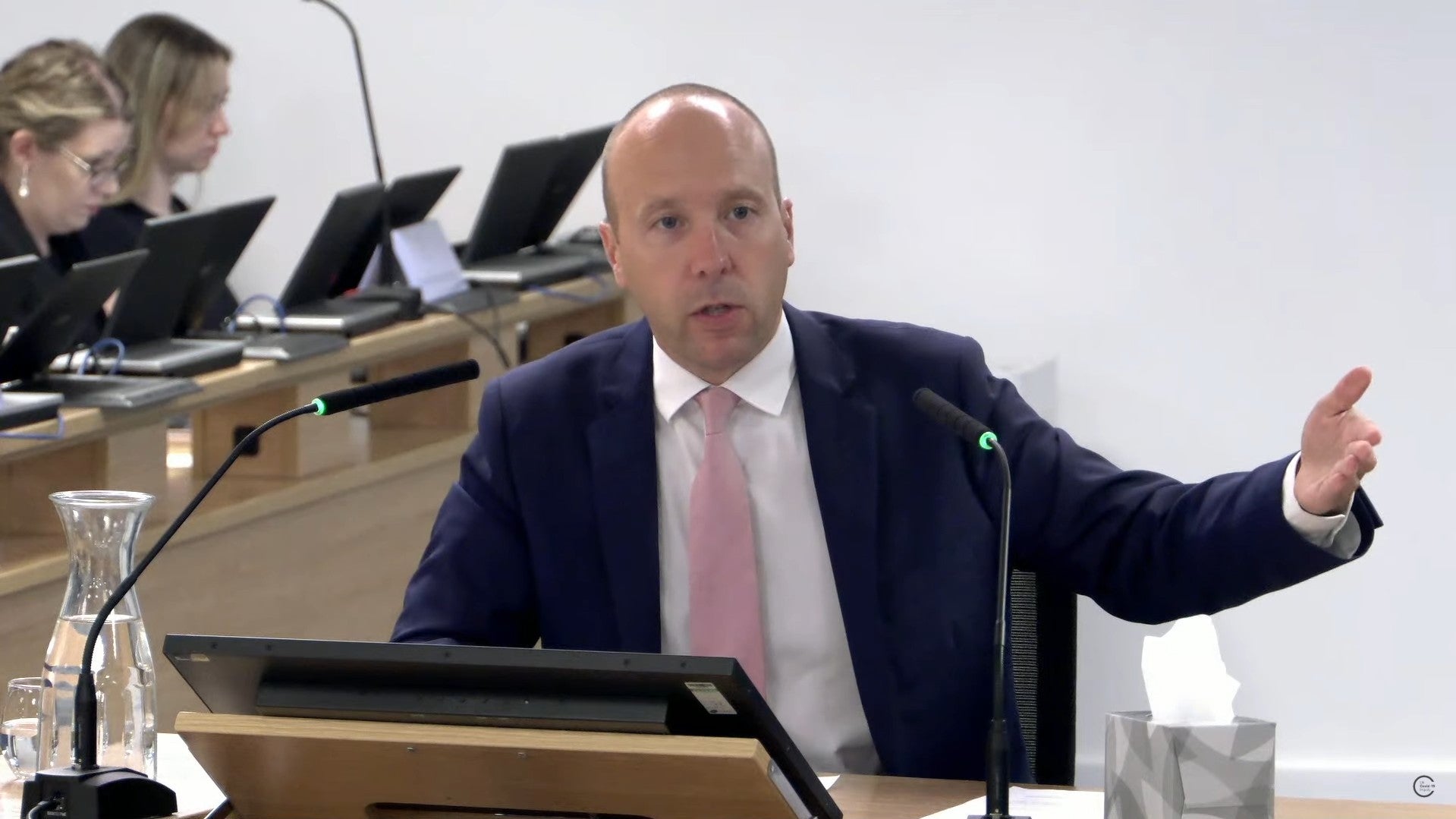Matt Hancock: Former health secretary defiant about Covid care home plan after ‘generational slaughter’ claim

Former health secretary Matt Hancock has defended the controversial policy of discharging hospital patients into care homes during the early stages of the Covid-19 pandemic, telling the UK Covid-19 Inquiry it was “the least-worst decision” at the time, despite the devastating death toll.
The policy, implemented in early 2020, saw patients rapidly moved from hospitals to care facilities in an effort to free up beds and prevent the NHS from being overwhelmed as the virus spread.
This strategy has come under intense scrutiny, particularly as the inquiry heard there were more than 43,000 deaths involving the virus in care homes across the UK between March 2020 and July 2022.
A civil servant earlier this week described the toll as a “generational slaughter within care homes”.
Appearing before the inquiry on Wednesday, Mr Hancock acknowledged the discharge policy was an “incredibly contentious issue”. However, he maintained: “Nobody has yet provided me with an alternative that was available at the time that would have saved more lives.”
The inquiry’s current focus on the care sector comes as bereaved people, whose loved ones died in care homes, continue to demand truth and accountability from those giving evidence.

However, there was no policy in place requiring patients to be tested before admission, or for asymptomatic patients to isolate, until mid-April.
This was despite growing awareness of the risks of people without Covid-19 symptoms being able to spread the virus.
Mr Hancock, who resigned from government in 2021 after admitting breaking social distancing guidance by having an affair with a colleague, has given evidence to the inquiry multiple times.
Returning for a full-day session to face questions specifically about the care sector, he said the hospital discharge policy had been a government decision but had been “driven” by then-NHS chief executive Sir Simon Stevens, now Lord Stevens.
Mr Hancock said: “It was formally a government decision. It was signed off by the prime minister. It was really driven by Simon Stevens, the chief executive of the NHS, but it was widely discussed.”
The inquiry heard Mr Hancock said in his witness statement that NHS England had “insisted” on the policy, and while he did not take the decision himself, he took responsibility for it as then-health secretary.
He said it was an “incredibly contentious issue” but added that “nobody has yet provided me with an alternative that was available at the time that would have saved more lives”.
He said there were no good options, adding: “It’s the least-worst decision that could have been taken at the time.”
Pressed further, he said he had both agreed with and defended the decision at the time.
The High Court ruled in 2022 that Government policies on discharging hospital patients into care homes at the start of the pandemic were “unlawful”.

While the judges said it was necessary to discharge patients “to preserve the capacity of the NHS”, they found it was “irrational” for the Government not to have advised that asymptomatic patients should isolate from existing residents for 14 days after admission.
Asked about March 17, 2020 when NHS bosses were instructed to begin the discharge process, Mr Hancock said officials were “pushing very hard” to get more PPE into care homes. He said not advising care homes to isolate returning residents without symptoms was a “mistake”, but it was in line with clinical guidance at the time.
In 2023, appearing for a separate module of the inquiry, Mr Hancock admitted the so-called protective ring he said had been put around care homes early in the pandemic was not an unbroken one, and said he understood the strength of feeling people have on the issue.
It’s frankly ridiculous and insulting that he says they tried to throw a protective ring around care homes when his department’s policies caused Covid to spread like wildfire amongst society’s most vulnerable loved ones
At a Downing Street press conference on May 15 2020, Mr Hancock said: “Right from the start, we’ve tried to throw a protective ring around our care homes.”
Mr Hancock told the inquiry: “I would stress in that piece of rhetoric, what I said is that we had ‘tried’ – it was not possible to protect as much as I would have wanted.”
He added: “The protection, what at the time, was clearly not as much as we would have liked, but the alternatives were even worse.
“We were trying to put as much protection in place as possible.
“All I can do is take you back to the actual decisions and the resources that we had at that moment.
He went on: “We were trying to do everything that we possibly could, we were in bleak circumstances.”
Counsel to the inquiry Jacqueline Carey KC highlighted anonymous evidence given to the inquiry, saying: “One person in particular said he (Mr Hancock) blatantly lied about the situation with care homes, there was no blanket of protection. We were left to sail our own ships. He wasn’t heartfelt. He had no understanding or appreciation of the challenges care homes face, pandemic or not, it felt like we were the sacrifice, a cull of older people who could no longer contribute to the society.”

Mr Hancock said it was “not helpful” for the inquiry to “exchange brickbats”, but went on: “I’ve been through everything that we did as a Department, a big team effort, and we were all pulling as hard as we possibly could to save lives – that’s what I meant by saying that we tried to throw a protective ring around.
“Of course, it wasn’t perfect. It was impossible – it was an unprecedented pandemic, and the context was exceptionally difficult.
“What I care about is the substance of what we did, the protections that we put in place, and most importantly, what we can do in the future to ensure that the options available are better than they were last time.”
Bereaved families have previously called this “protective ring” phrase a “sickening lie” and a “joke”.
Nicola Brook, a solicitor representing more than 7,000 families from Covid-19 Bereaved Families for Justice UK (CBFFJ), said Mr Hancock’s claim that the discharge policy had been the least-worst decision available was “an insult to the memory of each and every person who died”.
She added: “He knew at the time that many care homes did not have the ability to isolate the people who would be discharged from hospital and that Covid was airborne.
“It’s frankly ridiculous and insulting that he says they tried to throw a protective ring around care homes when his department’s policies caused Covid to spread like wildfire amongst society’s most vulnerable loved ones.
“Mr Hancock claims the decision to discharge people into care homes was driven by Simon Stevens, the chief executive of the NHS, yet the inquiry is not calling him. We would call for this decision to be urgently reviewed.”
The CBFFJ group had already written to inquiry chairwoman Baroness Heather Hallett, to express their concern at some “key decision-makers” not expected to be called in this module, including former prime minister Boris Johnson.
Outlining the state of the adult social care sector at the outbreak of the pandemic, Mr Hancock said it “was badly in need of, and remains badly in need of, reform”, but rejected the suggestion of it being a “Cinderella service to the NHS”.
He said pandemic contingency plans, prepared by local authorities for adult social care, had been “as good as useless” at the time, and described a “hodge podge of accountability” between local councils and Government departments.
He claimed the situation has “got worse not better” for care homes in the event of another pandemic hitting, and suggested a series of recommendations, including having isolation facilities in care homes and ensuring a stockpile of personal protective equipment (PPE).
Module six of the inquiry is focused on the effect the pandemic had on both the publicly and privately funded adult social care sector across the UK.
Public hearings for the care sector module are expected to run until the end of July.




